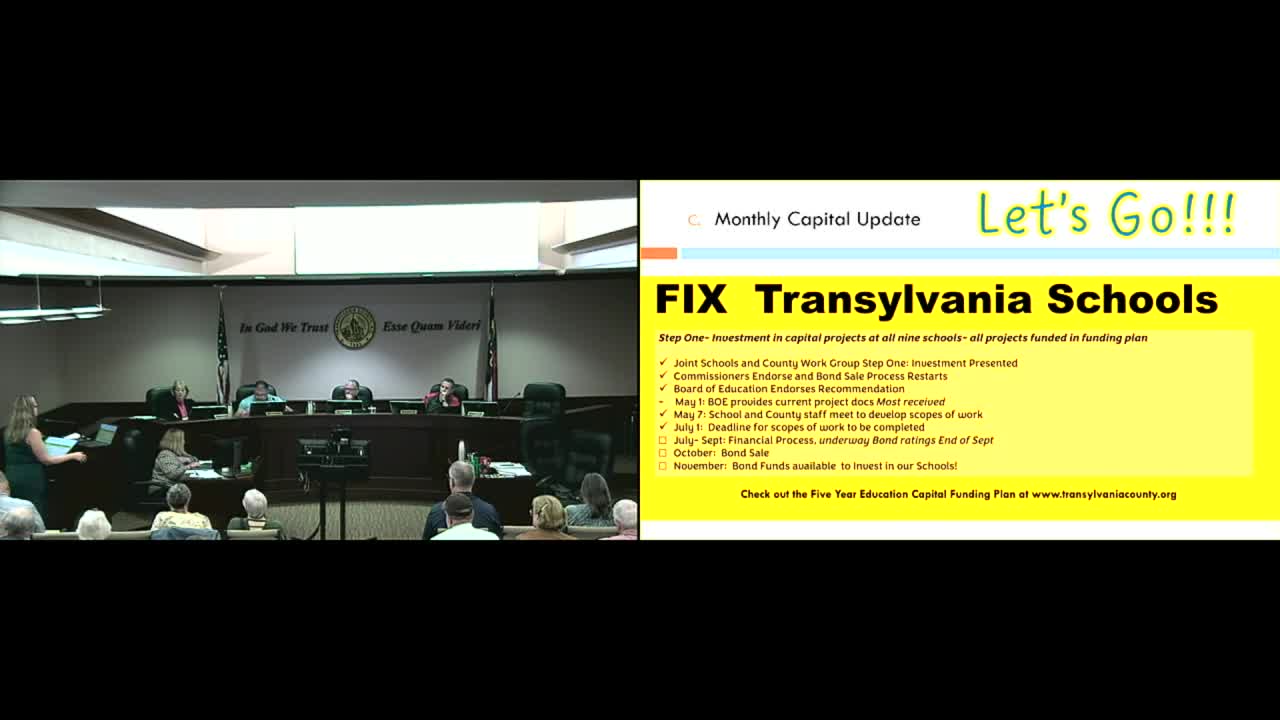County tackles housing crisis with innovative partnerships and strategies
September 23, 2024 | Transylvania County, North Carolina
This article was created by AI summarizing key points discussed. AI makes mistakes, so for full details and context, please refer to the video of the full meeting. Please report any errors so we can fix them. Report an error »

During a recent government meeting, officials discussed the anticipated second-highest interest rates for upcoming sales in North Carolina, emphasizing the competitive nature of the market. The specifics of the bids will be revealed at the end of the sale day, providing insight into the best proposals available.
The meeting also highlighted ongoing efforts in affordable housing within the county, linking these initiatives to essential infrastructure such as water, sewer, and broadband. Adam D. presented a comprehensive overview of the county's historical involvement in affordable housing, noting the necessity of collaboration among local government, private developers, and non-profit organizations to effectively address the housing shortage.
A key takeaway from the discussion was the acknowledgment that while local government plays a crucial role, it cannot single-handedly resolve the housing crisis. The presentation underscored the importance of a multi-faceted approach, involving profit-driven contractors, non-profits that support low-income families, and local government entities that face statutory limitations on funding allocations.
The county's affordable housing strategy is constrained by federal definitions, which classify affordable housing as costing no more than 30% of a household's income. Local governments can primarily invest in housing for those earning up to 60% of the median income, with limited flexibility for those earning between 60% and 80%. This regulatory framework complicates the development of housing projects, particularly in areas where market rents exceed federal fair market rent estimates.
Efforts to address these challenges include advocating for changes to the fair market rent methodology, which has been a persistent issue since 2018. The county has engaged with federal representatives and explored local surveys to better reflect the housing market's realities, but has faced obstacles in securing necessary data.
The meeting also touched on the impact of COVID-19 on housing stability, with the county disbursing significant funds for rent and utility assistance. Additionally, infrastructure investments totaling $50 million have been secured to support housing and economic development, alongside $15 million for broadband expansion, which aims to connect the remaining homes lacking high-speed internet access.
Looking ahead, the county plans to continue advocating for infrastructure investments and enhancing partnerships with local builders and non-profits. A new initiative with the North Carolina Impact Program aims to establish a dedicated team to explore available resources and educate stakeholders on the complexities of housing development.
Overall, the discussions underscored the county's commitment to addressing housing challenges through collaborative efforts and strategic planning, while navigating the regulatory landscape that governs affordable housing initiatives.
The meeting also highlighted ongoing efforts in affordable housing within the county, linking these initiatives to essential infrastructure such as water, sewer, and broadband. Adam D. presented a comprehensive overview of the county's historical involvement in affordable housing, noting the necessity of collaboration among local government, private developers, and non-profit organizations to effectively address the housing shortage.
A key takeaway from the discussion was the acknowledgment that while local government plays a crucial role, it cannot single-handedly resolve the housing crisis. The presentation underscored the importance of a multi-faceted approach, involving profit-driven contractors, non-profits that support low-income families, and local government entities that face statutory limitations on funding allocations.
The county's affordable housing strategy is constrained by federal definitions, which classify affordable housing as costing no more than 30% of a household's income. Local governments can primarily invest in housing for those earning up to 60% of the median income, with limited flexibility for those earning between 60% and 80%. This regulatory framework complicates the development of housing projects, particularly in areas where market rents exceed federal fair market rent estimates.
Efforts to address these challenges include advocating for changes to the fair market rent methodology, which has been a persistent issue since 2018. The county has engaged with federal representatives and explored local surveys to better reflect the housing market's realities, but has faced obstacles in securing necessary data.
The meeting also touched on the impact of COVID-19 on housing stability, with the county disbursing significant funds for rent and utility assistance. Additionally, infrastructure investments totaling $50 million have been secured to support housing and economic development, alongside $15 million for broadband expansion, which aims to connect the remaining homes lacking high-speed internet access.
Looking ahead, the county plans to continue advocating for infrastructure investments and enhancing partnerships with local builders and non-profits. A new initiative with the North Carolina Impact Program aims to establish a dedicated team to explore available resources and educate stakeholders on the complexities of housing development.
Overall, the discussions underscored the county's commitment to addressing housing challenges through collaborative efforts and strategic planning, while navigating the regulatory landscape that governs affordable housing initiatives.
View full meeting
This article is based on a recent meeting—watch the full video and explore the complete transcript for deeper insights into the discussion.
View full meeting
